Egg fruit tree, Canistel
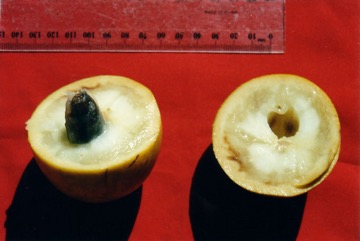
It is native to C and S America. It is a tropical and subtropical plant. It suits the coast in the tropics and is damaged by frost. It can grow up to 1400 m in the tropics. It will grow on fairly poor soils. It does better on fertile well drained soils. It can tolerate reasonably dry periods. In Brisbane Botanical Gardens. In XTBG Yunnan. It suits hardiness zones 10-11.
Also known as:
Amarillo, Boracho, Caca de nino, Cahixo, Caniste, Canizte, Costiczapotl, Cucumu, Eivrucht, Fruta huevo, Gema-de-ovo, Guaicume, Guicume, Huicon, Huicumo, Jaman phol, Kanis, Kaniste, Kanisutel, Kanixte, Khema, Limoncillo, Mamee ciruela, Mamey cerera, Mamey cerilla, Mzeituni, Nochi, Pohon sawo mentega, Rata lawulu, Sapota-amarelo, Sapote amarillo, Sapote borracho, Siguapa, Ti-essa, Tiesa, Tiyesa, Toesa, Yellow sapote, Zapote amarillo, Zapote mante, Zapotillo, Zubul
Synonyms
- Lucuma campechiana Kunth
- Lucuma glabrifolia Pittier
- Lucuma heyderi Standl.
- Lucuma nervosa A. DC.
- Lucuma palmeri Fernald
- Lucuma rivicoa Gaertn.f.
- Lucuma rivicoa var. angustifolia Miq.
- Lucuma salicifolia Kunth
- Richardella campechiana (Hunb. Bonpl. & Kunth.) Pierre
- Richardella rivicoa Gaertn.
- Radlkoferella glabrifolia (Pittier) Aubrev.
- Vitellaria salicifolia (Kunth) Engl.
Edible Portion
- Fruit, Kernel, Nuts
Where does Egg fruit tree grow?
Found in: Africa, Amazon, Asia, Australia, Bahamas, Bangladesh, Belize, Brazil, Cambodia, Cameroon, Caribbean, Central Africa, Central America, China, Colombia, Costa Rica, Cuba, East Africa, El Salvador, FSM, Guatemala, Hawaii, Honduras, Indochina, Indonesia, Jamaica, Japan, Kenya, Leeward Is., Malaysia, Maldives, Mexico, Micronesia, Nicaragua, North America, Pacific, Panama, Papua New Guinea, PNG, Philippines, Pohnpei, Puerto Rico, SE Asia, Seychelles, South America, Sri Lanka, St Lucia, Suriname, Tanzania, Uganda, United States, Venezuela, West Indies, Windward Is.
Notes: There are about 150-320 Pouteria species. They grow in the tropics.
Status: It is a cultivated food plant. It is only being tried out in Papua New Guinea.
Growing Egg fruit tree, Canistel
Cultivation: Trees are normally grown from seed. Seed need to be planted fresh. Seeds germinate in 2-3 weeks. Seedlings can be planted out after one year. A spacing of 4 m is suitable. It benefits from mulching due to the shallow root system. Plants can also be grafted and grown by air-layering. A spacing of 7-8 m is suitable. Trees should be lightly pruned to give 4-5 well spaced branches.
Edible Uses: The fruit is eaten fresh or made into icecream. The skin and seeds are removed. It is not good cooked but is used instead of pumpkin in pie. It is used in cakes, pies, custards and puddings. It is used in fruit cups, ice cream and milk shakes. It is often eaten with lemon juice. It can also be eaten with pepper and salt.
Production: Seedlings and grafted trees grow quickly. It begins bearing at about 3-5 years old. Grafted trees produce a year or so earlier. Fruit are harvested when they develop their full yellow colour. Fruit should be clipped when mature and ripened at room temperature for 3 to 10 days. Putting a little salt on the end of the fruit stalk hastens ripening. Fruit ripen 5-6 months after flowering.
Nutrition Info
per 100g edible portion| Edible Part | Energy (kcal) | Protein (g) | Iron (mg) | Vitamin A (ug) | Vitamin c (mg) | Zinc (mg) | % Water |
|---|---|---|---|---|---|---|---|
| Fruit | 139 | 1.68 | 0.92 | 320 | 58 | - | 60.6 |
Egg fruit tree, Canistel Photos

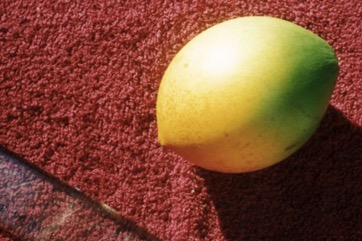
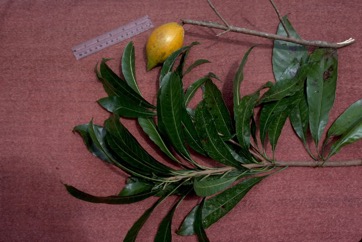
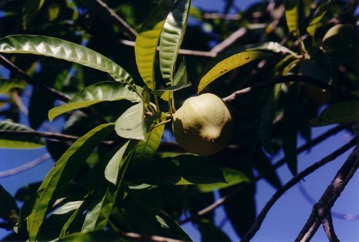
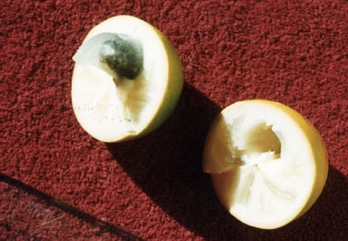
References
Aiguo, C. & Zhiling, D., 2001, Managing Agricultural Resources for Biodiversity Conservation. Case Study Yunnan, Southwest China. Environment Liaison Center International. p 41 (As Lucuma nervosa)
Arora, R. K., 2014, Diversity in Underutilized Plant Species - An Asia-Pacific Perspective. Bioversity International. p 82
Ashton, M. S., et al 1997, A Field Guide to the Common Trees and Shrubs of Sri Lanka. WHT Publications Ltd. pdf p 359
Barwick, M., 2004, Tropical and Subtropical Trees. A Worldwide Encyclopedic Guide. Thames and Hudson p 345
Candollea 9:398. 1942
Coronel, R.E., 1982, Fruit Collections in the Philippines. IBPGR Newsletter p 8
Cruz, I. M., et al, 2015, Edible fruits and seeds in the State of Mexico. Revista Mexicana de Ciencias Agricolas. Vol. 6. Num. 2 pp 331-346
Cundall, P., (ed.), 2004, Gardening Australia: flora: the gardener's bible. ABC Books. p 1078
Darley, J. J., 1993, Know and Enjoy Tropical Fruit. P & S Publishers. p 112
Facciola, S., 1998, Cornucopia 2: a Source Book of Edible Plants. Kampong Publications, p 228
Food Composition Tables for use in East Asia FAO http://www.fao.org/infoods/directory No. 835
Fouqué, A., 1972, Espèces fruitières d'Amérique tropicale. Institut français de recherches fruitierès outre-mer (ifac) (As Richardella nervosa)
French, B.R., 1986, Food Plants of Papua New Guinea, A Compendium. Asia Pacific Science Foundation p 262
Fu, Yongneng, et al, 2003, Relocating Plants from Swidden Fallows to Gardens in Southwestern China. Economic Botany, 57(3): 389-402 (As Lucuma nervosa)
Gouldstone, S., 1983, Growing your own Food-bearing Plants in Australia. Macmillan p 82 (As Lucuma nervosa)
Grandtner, M. M., 2008, World Dictionary of Trees. Wood and Forest Science Department. Laval University, Quebec, Qc Canada. (Internet database http://www.wdt.qc.ca)
Hermandez Bermejo, J.E., and Leon, J. (Eds.), 1994, Neglected Crops. 1492 from a different perspective. FAO Plant Production and Protection Series No 26. FAO, Rome. p 17
Hibbert, M., 2002, The Aussie Plant Finder 2002, Florilegium. p 239
http://www.ntbg.org/plants/plant details.php
Ibarra-Manriquez, G., et al, 1997, Useful Plants of the Los Tuxtlas Rain Forest (Veracruz, Mexico): Considerations of their Market Potential. Economic Botany, Vol. 51, No. 4, pp. 362-376
Jardin, C., 1970, List of Foods Used In Africa, FAO Nutrition Information Document Series No 2.p 156
John, L., & Stevenson, V., 1979, The Complete Book of Fruit. Angus & Robertson p 93. Also p 93, 292 (As Lucuma salicifolia)
Kermath, B. M., et al, 2014, Food Plants in the Americas: A survey of the domesticated, cultivated and wild plants used for Human food in North, Central and South America and the Caribbean. On line draft. p 686
Kiple, K.F. & Ornelas, K.C., (eds), 2000, The Cambridge World History of Food. CUP p 1744
Llamas, K.A., 2003, Tropical Flowering Plants. Timber Press. p 344
Lorenzi, H., Bacher, L., Lacerda, M. & Sartori, S., 2006, Brazilian Fruits & Cultivated Exotics. Sao Paulo, Instituto Plantarum de Estuados da Flora Ltda. p 620
Macmillan, H.F. (Revised Barlow, H.S., et al) 1991, Tropical Planting and Gardening. Sixth edition. Malayan Nature Society. Kuala Lumpur. p 306
Martin, F. W., et al, 1987, Perennial Edible Fruits of the Tropics. USDA Handbook 642 p 61
Martin, M.A., 1971, Introduction L'Ethnobotanique du Cambodge. Centre National de la Recherche Scientifique. Paris. (As Richardella campechiana)
Melander, M., 2007, Endangered plants on the market in Havana City, Cuba. Uppsala University, Sweden p 19
Menninger, E.A., 1977, Edible Nuts of the World. Horticultural Books. Florida p 33
Miguel, E., et al, 1989, A checklist of the cultivated plants of Cuba. Kulturpflanze 37. 1989, 211-357
Milow, P., et al, 2013, Malaysian species of plants with edible fruits or seeds and their evaluation. International Journal of Fruit Science. 14:1, 1-27
Morton, Julia F., 1987, Fruits of Warm Climates. Creative Resources Systems, Inc. . p. 402
Niwano, Y. et al., 2009, Extensive Screening for Plant Foodstuffs in Okinawa, Japan with Anti-Obese Activity on Adipocytes, in vitro. Plant Foods in Human Nutrition 64:6-10 (As Lucuma nervosa)
Pasha, M. K. & Uddin, S. B., 2019, Minor Edible Fruits of Bangladesh. Bangladesh J. Plant Taxon. 26(2): 299–313
Pennington, T.D., 1990, Sapotaceae in Flora Neotropica Monograph 52. New York Botanical Gardens. p 382
Phon, P., 2000, Plants used in Cambodia. © Pauline Dy Phon, Phnom Penh, Cambodia. p 511
Popenoe,
PROSEA (Plant Resources of South East Asia) handbook, Volume 2, 1991, Edible fruits and nut. p 258
Purseglove, J.W., 1968, Tropical Crops Dicotyledons, Longmans. p 646
Recher, P, 2001, Fruit Spirit Botanical Gardens Plant Index. www.nrg.com.au/~recher/ seedlist.html p 3
Segura, S., et al, 2018, The edible fruit species in Mexico. Genet Resour Crop Evol (2018) 65:1767–1793
Sharma, B.B., 2005, Growing fruits and vegetables. Publications Division. Ministry of Information and broadcasting. India. p 58
Smith, N., Mori, S.A., et al, 2004, Flowering Plants of the Neotropics. Princeton. p 344
Soerianegara, I. & Lemmens, R. H. M. L., (Eds.) 1993, Timber trees: Major commercial timbers. Plant Resources of South-East Asia. Wageningen. No. 5(1). p 363
Staples, G.W. and Herbst, D.R., 2005, A tropical Garden Flora. Bishop Museum Press, Honolulu, Hawaii. p 521 (Drawing)
Tankard, G., 1990, Tropical fruit. An Australian Guide to Growing and using exotic fruit. Viking p 32
USDA, ARS, National Genetic Resources Program. Germplasm Resources Information Network - (GRIN). [Online Database] National Germplasm Resources Laboratory, Beltsville, Maryland. Available: www.ars-grin.gov/cgi-bin/npgs/html/econ.pl (10 April 2000)
van Wyk, B., 2005, Food Plants of the World. An illustrated guide. Timber press. p 304
Vivien, J., & Faure, J.J., 1996, Fruitiers Sauvages d'Afrique. Especes du Cameroun. CTA p 328 (As Richardella nervosa)
F. W. H. A. von Humboldt et al., Nov. gen. sp. 3:189[folio]; 3:241[quarto]. 1819 (As Lucuma salicifolia)
Walter, A. & Sam C., 2002, Fruits of Oceania. ACIAR Monograph No. 85. Canberra. p 281
Wickens, G.E., 1995, Edible Nuts. FAO Non-wood forest products. FAO, Rome. p152
World Checklist of Useful Plant Species 2020. Royal Botanic Gardens, Kew
www.worldagroforestrycentre.org/treedb/
Zawiah, N. & Othaman, H., 2012, 99 Spesies Buah di FRIM. Institut Penyelidikan Perhutanan Malaysia. p 200